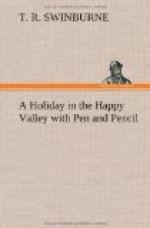It is further told how, when the attack began, two Mogul chiefs of note were engaged within upon a game of chess. Confident of the strength of the defence, they continued their game, unheeding the din of battle. Suddenly the foe broke in upon them, upon which they calmly asked for leave to finish their interesting match. The request was granted by the courtly Rajputs, but upon its termination they were both put to death.
Udaipur lies in a well-cultivated basin, shut in by a ring of arid hills. After skirting the flanks of some of the outlying spurs, we bustled through a tunnel and drew up at a bright little station, draped with great blue and pink convolvulus. And this was Udaipur.
We were picked out of the usual jabbering, jostling, gibbering crowd of natives by our host, who, looking most enviably cool and clean, took his heated, dishevelled, and unbarbered guests off to a comfortable carriage, and we were quickly sped towards tiffin and a bath.
The station is a long way from the town, as the Maharana, a most staunch conservative of the old school, having the railway more or less forced upon him, drew the line at three miles from his capital, and fixed the terminus there. One cannot help being glad that the prosaic steam-engine, crowned with foul smoke and heralded by ear-piercing whistles, has not been allowed to trespass in Udaipur, wherein no discordant note is struck by train line or factory chimney, and where everything and every one is as when the city was newly built on the final abandonment of Chitor, the ancient capital of Mewar.
Here in the heart of the most conservative of native States, whose ruler, the Maharana, Sir Fateh Singh, claims descent from that ancient luminary the Sun, we found novelty and interest in every yard of the three miles that stretch between the station and the capital. The scrub-covered desert has given place to a wooded and cultivated valley, ringed by a chain of hills, sterile and steep. The white ribbon of the road, through whose dust plough stolid buffaloes and strings of creaking bullock-carts, is bordered by tall cactus and yellow-flowered mimosa on either side. Among the trees rise countless half-ruined temples and chatries; on whose whitewashed walls are frequent frescoes of tigers or elephants rampant, and of wonderful Rajput heroes wearing the curious bell-shaped skirt, which was their distinctive dress.
The people too, their descendants, who crowd the road to-day, are remarkable—the men fine-looking, with beards brushed ferociously upwards, and all but the mere peasants carrying swords; the women, dark-eyed, and singularly graceful in their red or orange saris, and very full bell-shaped petticoats. Upright as darts, they walk with slightly swaying gesture, a slender brown arm upraised to support the big brass chatties on their heads, revealing an incredible collection of bangles on arms and ankles. These women are the descendants of those who, in the stormy days of the sixteenth century, while the Rajput princes still struggled heroically with the all-powerful Mogul emperors, preferred death to shame, and, led by Kurnavati (mother of Oodi Singh, the founder of Udaipur), accepted the “Johur,” or death by fire and suffocation, to the number of 13,000, while their husbands and brothers threw open the city gates and went forth to fight and fall.




